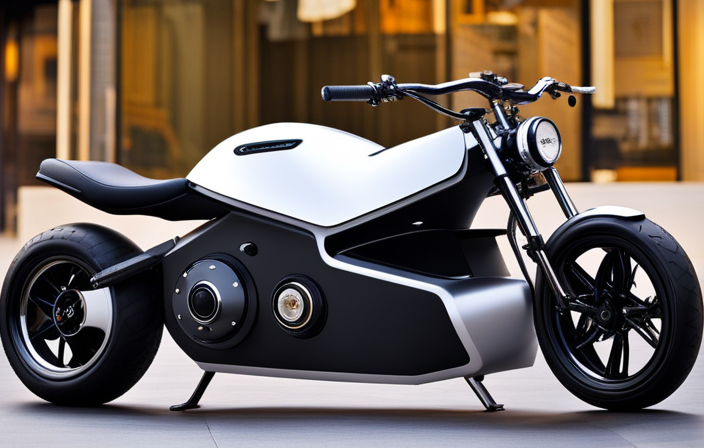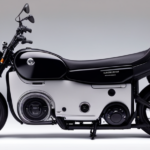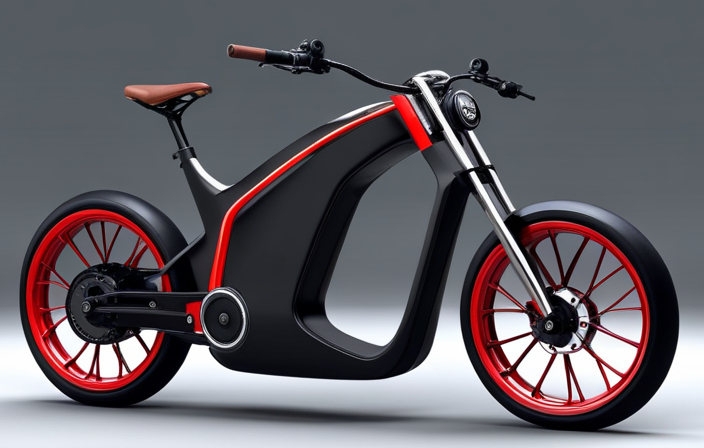Are you annoyed by the persistent clicking noise coming from the solenoid of your pit bike’s electric start? Curious as to why it’s not engaging? No need to fret, we have a solution for you.
In this article, we’ll delve into the potential causes behind this issue and guide you through a step-by-step troubleshooting process. So, if you’re ready to get your pit bike up and running smoothly again, let’s dive in and unravel the mystery of the clicking solenoid.
Key Takeaways
- Addressing wiring problems is crucial for resolving the issue of the solenoid just clicking.
- Inspecting components such as the starter button, fuse, kill switch, and ground connection is necessary to identify the root cause.
- Seeking professional assistance is important to accurately diagnose and repair the problem.
- Thorough diagnosis and effective repair of the electric start solenoid are essential to avoid further damage or incorrect repairs.
Understanding the Function of the Solenoid
The solenoid is responsible for clicking on your pit bike’s electric start. It plays a crucial role in the starting process by controlling the flow of electrical current from the battery to the starter motor.
Troubleshooting common solenoid issues can help identify the reason behind the clicking sound. One possible issue could be a faulty solenoid that is not able to engage the starter motor properly. Another issue could be a weak battery, which may not provide enough power for the solenoid to function correctly.
Understanding the role of the solenoid in the starting process is essential for diagnosing and fixing the problem. To investigate further, checking the battery voltage is recommended to ensure it is within the required range for the solenoid to operate effectively.
Checking the Battery Voltage
First, check if your battery has enough voltage. This is an essential step in diagnosing the clicking sound coming from the solenoid of your pit bike’s electric start.
To do this, start by checking the battery terminals. Ensure they are clean, tight, and free of corrosion.
Next, test the battery voltage under load using a multimeter. Connect the positive lead of the multimeter to the positive terminal of the battery and the negative lead to a good ground on the frame. Activate the electric start and observe the voltage reading. If the voltage drops significantly below the recommended level, it indicates a weak or discharged battery.
Once you have checked the battery voltage, it’s time to move on to inspecting the wiring connections, which will be discussed in the next section.
Inspecting the Wiring Connections
After checking the battery voltage, it’s time to inspect the wiring connections. This step is crucial in troubleshooting the ignition system and ensuring that the solenoid on your pit bike’s electric start is not just clicking.
Start by visually examining all the wiring connections, looking for any signs of damage, loose connections, or corrosion. Ensure that all wires are securely fastened and properly connected to their respective terminals.
Next, use a multimeter to test the wiring continuity by checking for any breaks or interruptions in the circuit. Pay close attention to the wires leading to the solenoid and the ignition switch. If any issues are detected, repair or replace the damaged wiring as necessary.
Once you have tested and ensured the integrity of the wiring connections, you can proceed to the next step of testing the starter motor.
Testing the Starter Motor
To test the starter motor, you need to connect it to a power source and see if it engages and turns over the engine. Here are some troubleshooting techniques to help you identify and address common starter motor issues:
-
Ensure the battery is fully charged and in good condition. A weak or faulty battery can cause the solenoid to click without engaging the starter motor.
-
Check the connections between the battery, solenoid, and starter motor. Loose or corroded connections can prevent the motor from receiving enough power to start the engine.
-
Use a multimeter to test the continuity of the starter motor. If there is no continuity, it may indicate a faulty motor that needs to be replaced.
-
Check the starter relay and fuse for any signs of damage or malfunction.
By following these troubleshooting techniques, you can determine if the starter motor is the cause of the clicking sound.
Next, we will move on to checking the ignition switch.
Checking the Ignition Switch
The next step is to check if the ignition switch is functioning properly. When troubleshooting the ignition switch, there are a few common solenoid problems to consider.
First, verify that the switch is receiving power by using a multimeter to test the voltage at the ignition switch terminals. If there is no power, the issue may lie in a blown fuse or a faulty wiring connection. Additionally, check for any signs of damage or corrosion on the ignition switch itself.
If everything appears to be in order, you can try bypassing the ignition switch by connecting the starter motor directly to the battery to see if it engages properly. If the starter motor works when bypassing the ignition switch, it may be necessary to replace the switch.
Now, let’s move on to inspecting the starter relay.
Inspecting the Starter Relay
Let’s now take a look at the starter relay. Inspecting the starter solenoid is an important step in troubleshooting the starter relay. Here are a few things to consider:
-
Physical inspection: Examine the relay for any signs of damage such as cracks, burns, or loose connections. These can affect the relay’s functionality and cause the clicking sound.
-
Electrical testing: Use a multimeter to check if there is proper voltage flowing through the relay. A low or no voltage reading could indicate a faulty relay.
-
Relay switch: Test the switch by applying power and checking if it clicks and engages the solenoid. A malfunctioning switch may not send the necessary signal to start the bike.
-
Wiring connections: Ensure all the wiring connections to the relay are secure and free from corrosion. Corroded terminals can disrupt the electrical flow.
Now that we have inspected the starter relay, let’s move on to cleaning corroded terminals in the subsequent section.
Cleaning Corroded Terminals
To ensure the smooth functioning of your electric start on your pit bike, it is essential to inspect and clean the corroded terminals of the starter relay. Corroded terminals can impede the flow of electricity and result in a clicking sound from the solenoid. Cleaning the terminals is a relatively simple task that can be accomplished with a few cleaning techniques. Start by disconnecting the battery to avoid any potential electrical shocks. Next, use a wire brush or sandpaper to gently remove the corrosion from the terminals. Once the terminals are clean, you can apply dielectric grease to prevent future corrosion. Regularly performing this preventative maintenance will help maintain the efficiency of your solenoid and ensure a reliable electric start. Moving on to the next step, we will now discuss how to test the solenoid with a multimeter.
Testing the Solenoid with a Multimeter
Once you have cleaned the corroded terminals, you can use a multimeter to test the solenoid. Testing the solenoid with a multimeter is a crucial step in troubleshooting the electric start issue on your pit bike.
First, set your multimeter to the resistance (ohms) mode. Then, connect the positive lead of the multimeter to the positive terminal of the solenoid and the negative lead to the negative terminal.
A healthy solenoid should have a resistance reading within the manufacturer’s specified range. If the resistance reading is significantly higher or lower than the recommended range, it indicates a faulty solenoid that needs to be replaced.
Once you have tested the solenoid resistance, you can proceed to check for loose or damaged connections, which we will discuss in the next section.
Checking for Loose or Damaged Connections
To check for loose or damaged connections on your pit bike, visually inspect the wiring harness and connectors for any signs of wear, fraying, or loose connections. Pay close attention to the wires leading to the solenoid and check if they are securely connected. If you notice any loose or damaged connections, it’s important to fix or replace them, as they can cause the solenoid to malfunction.
When troubleshooting common solenoid issues, it’s crucial to consider the emotional impact that a faulty solenoid can have on your riding experience. The frustration of not being able to start your pit bike can be overwhelming, making it essential to address any potential wiring problems. By checking the solenoid wiring, you’re taking a proactive approach to ensure that your bike runs smoothly and reliably.
Moving forward, the next step is inspecting the starter button to further troubleshoot the issue.
Inspecting the Starter Button
Check if your starter button is functioning properly by inspecting it for any signs of damage or wear. Start by visually examining the button for any cracks, breaks, or loose connections. Additionally, check if the button feels loose or wobbly when pressed. If you notice any of these issues, it may indicate that the starter button is faulty and needs to be replaced.
To further test the functionality of the starter button, you can use a multimeter to check for continuity. Disconnect the wiring from the starter button and set the multimeter to the continuity setting. Place one probe on each terminal of the button and press it down. If the multimeter indicates continuity, it means that the starter button is working properly. However, if there is no continuity, it suggests that the button is defective and should be replaced.
With the starter button inspected, you can now move on to checking the fuse.
Checking the Fuse
Inspecting the starter button is an important step, but if that checks out fine, the next thing to do is check the fuse. The fuse is a safety device that protects the electrical system from overload. It’s possible that the fuse is blown, causing the solenoid to just click. To check the fuse, follow these steps:
- Locate the fuse box on your pit bike. It is usually located near the battery or under the seat.
- Remove the fuse cover and inspect the fuse for any signs of damage or a blown filament.
- If the fuse is blown, replace it with a new one of the same amperage rating.
After checking the fuse, the next step is to troubleshoot the ignition system by checking the solenoid wiring. This will help determine if there are any loose connections or faulty wiring that could be causing the issue. Once you have completed these steps, you can move on to testing the kill switch to further diagnose the problem.
Testing the Kill Switch
Once the fuse has been checked and replaced if necessary, it’s time to test the kill switch to see if it’s the cause of the problem. Testing the kill switch is an important step in troubleshooting the electric start on your pit bike.
Start by locating the kill switch, which is usually located on the handlebars. Turn the key to the ‘on’ position and press the kill switch to the ‘off’ position. If you hear a clicking sound when you press the kill switch, it means that the switch is functioning properly. However, if you do not hear any clicking sound, the kill switch may be faulty and needs to be replaced.
Moving on to the next step, let’s check the ground connection to ensure it is properly connected and not causing any issues.
Checking the Ground Connection
To ensure proper functioning, it’s important to make sure the ground connection is securely attached and not causing any issues with the kill switch on your pit bike. Troubleshooting methods and techniques can help identify and resolve any problems with the ground connection. One effective way to troubleshoot the ground connection is by visually inspecting it for any loose or corroded wires. Additionally, you can use a multimeter to test the continuity of the ground connection. Connect one probe to the ground wire and the other probe to a known good ground point on the bike. If there is no continuity, it indicates a faulty ground connection that needs to be fixed. By troubleshooting the ground connection, you can rule out any issues that may be causing the solenoid to click. Moving forward, inspecting the starter clutch will be the next step in diagnosing the issue.
Inspecting the Starter Clutch
Now, take a look at the starter clutch to see if there are any visible signs of damage or wear.
The starter clutch is an essential component of the electric start system in your pit bike. It engages with the starter gear to turn the engine over and initiate the ignition process.
If the starter clutch is faulty or worn out, it can cause the solenoid to click instead of engaging with the engine.
To check the starter clutch, remove the cover and inspect it for any signs of wear, such as excessive play, broken teeth, or oil leaks.
If you notice any of these issues, the starter clutch may need to be replaced. It is advisable to seek professional assistance to ensure the correct diagnosis and repair of the electric start system.
Seeking Professional Assistance
If you notice any signs of wear or damage on the starter clutch, it is advisable to seek professional assistance for the correct diagnosis and repair. Seeking professional advice is crucial in troubleshooting common solenoid issues.
A professional technician has the expertise and specialized tools necessary to accurately diagnose the problem and provide the appropriate solution. They will carefully inspect the solenoid and all related components to identify any faulty or damaged parts.
With their technical knowledge and experience, they can determine whether the solenoid needs to be replaced or if there are other underlying issues causing the clicking sound. Attempting to fix the problem without proper knowledge and tools can lead to further damage or incorrect repairs.
Therefore, it is best to rely on the expertise of a professional to ensure a thorough diagnosis and effective repair of your electric start solenoid.
Frequently Asked Questions
Why is my pit bike’s solenoid clicking but not starting?
If your pit bike’s solenoid is clicking but the engine is not starting, there may be a problem with the electrical circuit.
To troubleshoot this issue, you can start by testing the solenoid using a multimeter to check if it is receiving power and if it is functioning properly.
Additionally, you should inspect the wiring connections and battery voltage.
By following these troubleshooting steps, you can identify and resolve the issue with your pit bike’s solenoid.
How do I test the solenoid on my electric start pit bike?
To test the solenoid on your electric start pit bike, you need to follow specific testing procedures.
First, ensure your battery is fully charged.
Then, using a multimeter, check the resistance between the solenoid terminals. If the resistance is within the specified range, the solenoid is functioning correctly. If not, it may have a common problem such as a faulty coil or worn-out contacts.
Further troubleshooting may be required to pinpoint the exact issue.
What could be causing my pit bike’s solenoid to click repeatedly?
Possible solutions for your pit bike’s solenoid repeatedly clicking could be due to a faulty solenoid or a weak battery.
To troubleshoot, start by checking the battery voltage with a multimeter. If the voltage is low, charge or replace the battery.
If the voltage is within the normal range, the solenoid may need to be replaced. Ensure all connections are clean and tight.
If the issue persists, seeking professional assistance may be necessary.
What should I do if my pit bike’s solenoid is clicking but the engine won’t turn over?
If your pit bike’s solenoid is clicking but the engine won’t turn over, there are a few troubleshooting steps you can take.
First, check the starter motor to ensure it is functioning properly.
Inspect the electrical connections for any loose or corroded wires, as this can cause issues.
Additionally, make sure the battery is fully charged.
By thoroughly examining these elements, you can identify and resolve the problem, getting your pit bike back on track.
Are there any common troubleshooting steps I can take before seeking professional assistance for my pit bike’s solenoid issue?
To troubleshoot the solenoid issue on your pit bike, there are a few steps you can take before seeking professional assistance.
First, check the battery voltage and ensure it’s fully charged.
Next, inspect the wiring connections to make sure they’re secure and free from corrosion.
Also, test the solenoid by bypassing it with a jumper wire to see if the engine turns over.
If these troubleshooting steps don’t resolve the issue, it may be necessary to consult a professional for further assistance.
Conclusion
So, you’ve gone through all the necessary steps to troubleshoot why the solenoid on your pit bike’s electric start is just clicking.
You’ve checked the battery voltage, inspected the wiring connections, tested the starter motor, checked the ignition switch and kill switch, inspected the ground connection, and even inspected the starter clutch.
But despite all your efforts, the problem remains unresolved.
It’s time to seek professional assistance. Don’t worry, though. With the help of a skilled technician, you’ll soon have your pit bike up and running again, ready for your next thrilling ride.
Stay tuned for the resolution!
















